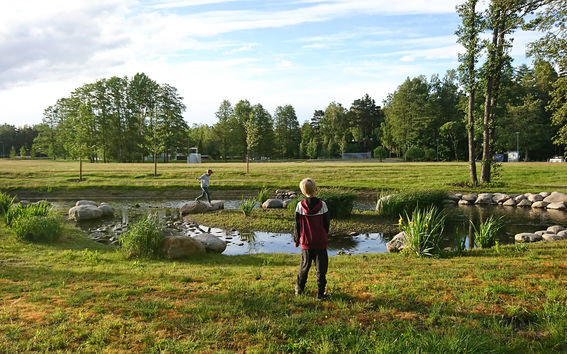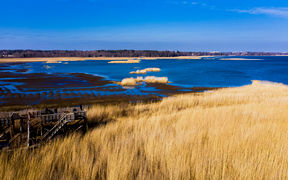The potential of urban green spaces in climate change mitigation

Compared to many European cities, Finnish cities are spacious, and on average they have considerably more green areas. However, cities are growing and densifying also in Finland, and the role of urban green spaces – the urban green – is changing.
‘The many benefits of green spaces are well known, but more research is needed on the importance of carbon sequestration and, for example, life cycle assessment of green infrastructure. Low carbon and carbon neutrality are already the top goals of many cities, but applied research data is needed to support planning and decision-making’, says Ranja Hautamäki, Associate professor of Landscape Architecture.
Research data is soon coming up. The aim of the multidisciplinary CO-CARBON project is to measure and model the carbon sequestration capacity of urban green. Solutions are being developed for more efficient use of urban green in climate change mitigation and adaptation.
The CO-CARBON project recently received funding from the Strategic Research Council (SRC) established within the Academy of Finland. It is implemented under the leadership of the University of Helsinki in co-operation with Aalto University, the Finnish Meteorological Institute, Häme University of Applied Sciences and the University of Copenhagen. The total funding allocated to the project is EUR 3.6 million, of which Aalto's share is approximately EUR 1 million.
Multidisciplinary cooperation and interaction
Plants and soil sequester atmospheric carbon, shape the microclimate and enhance stormwater management. At the same time, they also provide other benefits and support biodiversity and the well-being of residents.
Implementing nature-based solutions requires multidisciplinary and cross-sectoral cooperation, which is difficult in siloed decision-making.
Ranja HautamäkiThe challenge is how to make the diverse benefits of green spaces appear as a whole, and to be included effectively in decision-making."
‘The challenge is how to make the diverse benefits of green spaces appear as a whole, and to be included effectively in decision-making, instead of remaining in the margin’, Hautamäki reflects.
The research team includes atmospheric, soil and social scientists as well as landscape architects. According to Hautamäki, interdisciplinarity is essential when studying complex challenges such as climate change mitigation.
New solutions are being developed not only through scientific research but also interactively collaborating with residents, businesses, cities and other actors.
‘The goal is to develop design, construction and maintenance practices that enhance carbon sequestration along with other ecological and social benefits’, Hautamäki says.
Better planning and decision-making
In the project, the research group of the Department of Architecture at Aalto University examines carbon-smart planning at many levels: The city's urban green network as well as individual green spaces.
In two case study sites – Haakoninlahdenpuisto in Helsinki and Hiedanranta area in Tampere – carbon-smart practices are co-created and and evaluated together with local planners and other city officials.
The aim is to develop methods for life-cycle assessment of urban green and to provide cities with policy recommendations on carbon-smart urban green infrastructure.
‘The chosen design and implementation solutions of green spaces, as well as their maintenance practices have long-term implications on the quality and carbon footprint of the entire urban environment.’
Societal impact
Aalto University's Department of Architecture is also responsible for the interactive actions within the project. The research seeks to collaborate with various stakeholders: urban green users, designers and builders, companies and city authorities.
‘Research projects funded by the Strategic Research Council are required to plan for broad and effective societal impact, and to place effort in finding ways to apply scientific knowledge in practice. Thus, considerable investment has been made also in this project in terms of communication and interaction,’ explains Tiina Merikoski, postdoctoral researcher in charge of interaction of the project.
In addition to co-creative workshops and collaborative planning, societal impact of the project will be enhanced by media visibility and organizing events.
‘The most important event of the first year of the project is the CO-CARBON festival, which takes place at the turn of May-June. During the two-week event, we will organize, among other things, guided tours at the case areas, lectures and seminars, and workshops with, for example, urban planning experts and planners.’
Aalto University Department of Architecture team in the CO-CARBON project:
Ranja Hautamäki, associate professor, consortium deputy PI, work package leader
Tiina Merikoski, postdoctoral researcher, interaction coordinator
Matti Kuittinen, adjunct professor, responsible for the life cycle assessment research
Mari Ariluoma, researcher, doctoral candidate
Caroline Moinel, researcher, doctoral candidate
Sofia Kangas, research assistant
The CO-CARBON project is funded by the Strategic Research Council (SRC) established within the Academy of Finland and is part of SRC's Climate Change and Human Research Programme (CLIMATE). The research consortium is led by the University of Helsinki, and the partners in addition to Aalto University are the Finnish Meteorological Institute and Häme University of Applied Sciences. The total funding allocated to the project is EUR 3.6 million, of which Aalto's share is approximately EUR 1 million.
Funding for strategic research
Projects funded by the Academy of Finland study the importance of urban green spaces in carbon sequestration and the reliable utilization of social and health services data

Read more news

DeployAI Partners Gather for Heart Beat Meeting in Helsinki
The European DeployAI project's partners gathered for the Heart Beat meeting hosted by Aalto University Executive Education in Helsinki.
Get to know us: Associate Professor Maria Sammalkorpi
Sammalkorpi received her doctorate from Helsinki University of Technology 2004. After her defence, she has worked as a researcher at the Universities of Princeton, Yale and Aalto.
Aalto computer scientists in ICML 2024
Computer scientists in ICML 2024